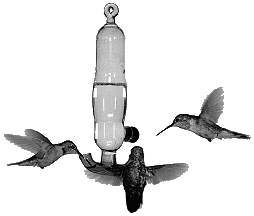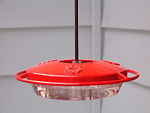[Published in 1968: Smithsonian Institution United States National Museum Bulletin 237 (Part 1): 447-466]
The eastern goldfinch belongs to a group of small, short tailed finches which includes the other American goldfinches and the siskins. These birds are closely related to the redpolls (Acanthis) and have traits in common; they collect in flocks during most of the year and constantly give their characteristic notes as they fly restlessly from place to place. They give the impression of being high-spirited birds, always happy and full of gaiety.
Bradford Torrey (1885) paints this picture of the goldfinch: "Our American goldfinch is the loveliest of birds. With his elegant song, and his more beautiful soul, he ought to be one of the best beloved, if not one of the most famous; but he has never yet had half his desserts. He is like the chickadee, and yet different. He is not so extremely confiding, nor should I call him merry. But he is always cheerful, in spite of his so-called plaintive note, from which he gets one of his names, and always amiable. So far as I know, he never utters a harsh sound; even the young ones, asking for food, use only smooth, musical tones. During the pairing season his delight often becomes rapturous. To see him then, hovering and singing--or, better still, to see the devoted pair hovering together, billing and singing--is enough to do even a cynic good." Roger T. Peterson (1935) says: "The responsibilities of life seem to rest lightly on the Goldfinch's sunny shoulders."
Spring.--Spring is not the goldfinch's spring, in the sense that spring is the beginning of a breeding season, because the goldfinch does not build its nest until summer is well advanced when many of its favorite plants have gone to seed.
Francis Beach White (1937) speaks thus of their arrival in Concord, N.H.: "On arrival in the spring, flocks great or small are likely to cluster in the foliage of large trees, and singing goes on by the hour; one of these flocks was estimated at a hundred birds. In June pairs are seen, and the undulations in flight develop till they give the effect of a bouncing ball. On July 7th, a male gave forth a torrent of song while flying on an even course with rapid wing beats, and then, having perched a moment, left with undulations closely compressed, fifteen feet deep or more. . . .In early July, the sexes are still flocking together, though some have apparently long been paired."
Dayton Stoner (1932) describes the goldfinch's occurrence in New York state in spring: "During the entire month of May flocks of eastern goldfinches are to be found almost everywhere about Oneida Lake, singing, and feeding on the buds of apple or the seeds of elm and other trees. . . . The small isolated wooded tracts and the open fields appeal to it and although a considerable local movement is displayed at this season it is without definite direction or objective. Often small flocks can be seen and heard as they pass high above the extensive wooded area north of Cleveland; they may even stop to rest and feed or sing in some of the trees, but they soon move on again. . . . Throughout June, also, the goldfinch continues its local wanderings, indulging its sociable tendencies and singing blithely in trees and orchards and on roadside telephone wires. It becomes then one of the most noticeable local species of birds."
The following, from my notes, describes a typical sight in eastern Massachusetts in spring: "A gathering of two or three hundred goldfinches, surely 90 percent males, feeding on the ground in a market garden among chickweed plants in bloom. They often whirled away, dozens at once, to telephone wires and the adjoining woods a field away, later returning to the ground again where they alighted with a quick turn. They sang in chorus from the trees."
Courtship.--John Burroughs (1904) describes an attractive little ceremony which takes place in spring: "When the change [in plumage] is complete, and the males have got their bright uniforms of yellow and black, the courting begins. All the goldfinches of a neighborhood collect together and hold a sort of musical festival. To the number of many dozens they may be seen in some large tree, all singing and calling in the most joyous and vivacious manner. The males sing, and the females chirp and call. Whether there is actual competition on a trial of musical abilities of the males before the females or not, I do not know. The best of feeling seems to pervade the company; there is no sign of quarreling or fighting; 'all goes merry as a marriage bell,' and the matches seem actually to be made during these musical picnics. . . . I have known the goldfinches to keep up this musical and love-making festival through three consecutive days of a cold northeast rainstorm. Bedraggled, but ardent and happy, the birds were not to be dispersed by wind or weather."
Witmer Stone (1937) speaks of a nuptial flight: "Occasionally we see a male Goldfinch flying high in the air more or less in circles, and after covering this imaginary track several times he will relapse into the usual undulating flight and drop back to his perch. This performance is apparently a display, incident to the mating season." Francis H. Allen says of the song-flight that "the bird keeps on a level with the wings flapping rapidly and steadily instead of taking the undulating course as in ordinary flight."
Aretas A. Saunders (1938) reports: "On July 27, 1933, I observed what was apparently a courtship flight accompanied by song. The pair of birds was flying about over an open area, not far from a nest discovered later that year. They flew in great circles from 50 to 80 feet from the ground, undulating up and down, and the male singing a long continued song. After circling about several times they flew away, the male changing from song to the ordinary 'perchickery' notes."
I have seen several times a curious modification of this song-flight and find it mentioned twice in my notes: "May 21, 1913. One of four goldfinches, flying about above the trees (good-sized willows), changed from his ordinary flight to a slow, labored flight, the wings moving in leisurely, heavy beats. The performance suggested the flight of a chat when he mounts into the air and dangles his legs. In changing to this labored flight the bird, a male, appeared at once to become twice his former size, for the reason, I suppose, because we now associate slow wing-beats with a good-sized bird." And on July 11, 1913: "A male goldfinch flying above trees, singing. Flight is a series of slow flaps with his wings, giving the impression of a bird as large as a crow seen in the distance."
Nesting.--The goldfinch breeds so late in the season that full-size leaves afford ample concealment for the nest. Walter P. Nickell (1951) made a study covering 264 nests in Michigan during the period 1933-49. The reader is referred to his lengthy paper. The earliest date on which a nest was found containing eggs was July 6, the latest date for a nest containing young was September 25.
Nesting sites were not over 300 yards from feeding areas and the better the food supply, the greater the density of nests. Greatest density was in swamps. The species is tolerant in respect to territorial boundaries. Food seems more important. No nest was far away from an abundant supply of thistle seed. Territory which lacked thistle but which seemed otherwise appropriate was not used. Nickell lists an overall total of 36 species of trees and shrubs used for nesting. L. H. Walkinshaw (1938) supplies, in addition, an ash, Fraxinus sp., and Sassafras variifolium.
Nickell found nests ranging in height from 33 feet above the ground, in a red oak, to one foot in a hawthorn. Nests may be located in upright forks with an average of four vertical twigs evenly spaced to form a cradle. At times one side is unsupported. Another type is held between parallel uprights without support underneath. Another type rests in cradles of twigs on a horizontal branch. A fifth type is saddled over and around horizontal branches and fastened to small horizontal twigs or leaves. In two instances nests were wedged between horizontal forks, held in place by the overlapping of the nesting materials and by attachment on two sides, without support underneath. This nest, thus, resembles the semipensile nests of the vireos. Nests are so durable they will last several years, and so tightly woven they will hold water temporarily. The lining is of soft and warm materials, thinning towards the rim, frequently composed of thistle and/or cattail down. Spider silk and caterpillar webs are used to bind the rim of the nest with bark or stronger material such as grape or hawthorn.

















































 A Little History...
A Little History... Any feeder can attract hummers, so perhaps the most important design feature to look for is ease of disassembly and cleaning. In this respect, the basin-style feeders are much, much better than the inverted-bottle types. I recommend the HummZinger and similar well-designed basin feeders for their ruggedness as well as their ease of maintenance. Hummingbirds will come to any feeder that holds fresh syrup, so you might as well buy one that's easy for you to keep up - if it's easy, you're more likely to do it faithfully, and that's important.
Any feeder can attract hummers, so perhaps the most important design feature to look for is ease of disassembly and cleaning. In this respect, the basin-style feeders are much, much better than the inverted-bottle types. I recommend the HummZinger and similar well-designed basin feeders for their ruggedness as well as their ease of maintenance. Hummingbirds will come to any feeder that holds fresh syrup, so you might as well buy one that's easy for you to keep up - if it's easy, you're more likely to do it faithfully, and that's important.